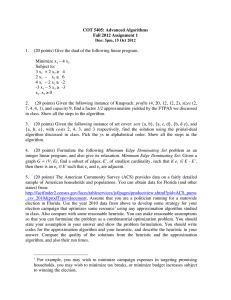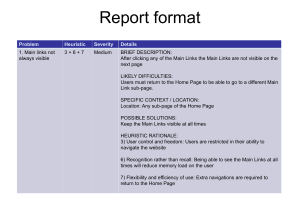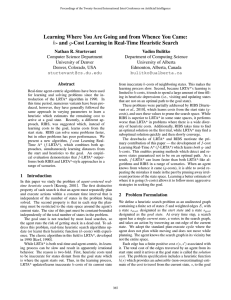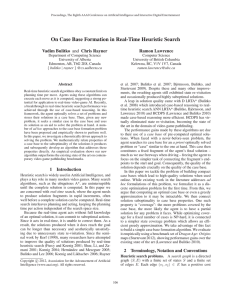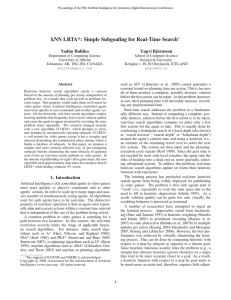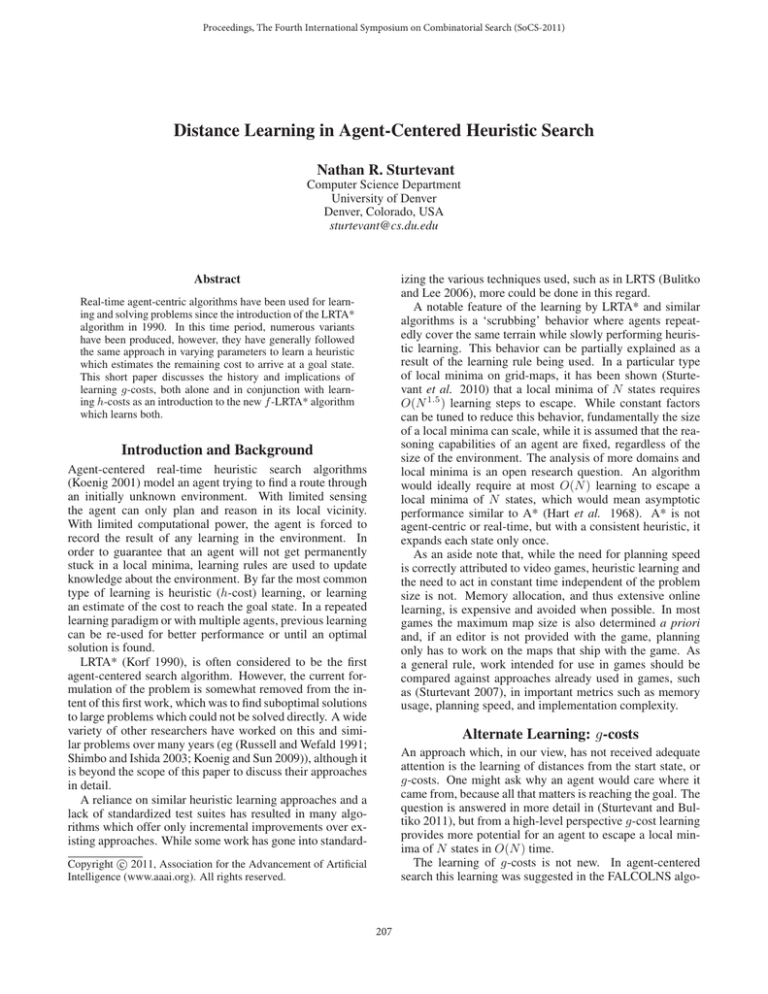
Proceedings, The Fourth International Symposium on Combinatorial Search (SoCS-2011)
Distance Learning in Agent-Centered Heuristic Search
Nathan R. Sturtevant
Computer Science Department
University of Denver
Denver, Colorado, USA
sturtevant@cs.du.edu
izing the various techniques used, such as in LRTS (Bulitko
and Lee 2006), more could be done in this regard.
A notable feature of the learning by LRTA* and similar
algorithms is a ‘scrubbing’ behavior where agents repeatedly cover the same terrain while slowly performing heuristic learning. This behavior can be partially explained as a
result of the learning rule being used. In a particular type
of local minima on grid-maps, it has been shown (Sturtevant et al. 2010) that a local minima of N states requires
O(N 1.5 ) learning steps to escape. While constant factors
can be tuned to reduce this behavior, fundamentally the size
of a local minima can scale, while it is assumed that the reasoning capabilities of an agent are fixed, regardless of the
size of the environment. The analysis of more domains and
local minima is an open research question. An algorithm
would ideally require at most O(N ) learning to escape a
local minima of N states, which would mean asymptotic
performance similar to A* (Hart et al. 1968). A* is not
agent-centric or real-time, but with a consistent heuristic, it
expands each state only once.
As an aside note that, while the need for planning speed
is correctly attributed to video games, heuristic learning and
the need to act in constant time independent of the problem
size is not. Memory allocation, and thus extensive online
learning, is expensive and avoided when possible. In most
games the maximum map size is also determined a priori
and, if an editor is not provided with the game, planning
only has to work on the maps that ship with the game. As
a general rule, work intended for use in games should be
compared against approaches already used in games, such
as (Sturtevant 2007), in important metrics such as memory
usage, planning speed, and implementation complexity.
Abstract
Real-time agent-centric algorithms have been used for learning and solving problems since the introduction of the LRTA*
algorithm in 1990. In this time period, numerous variants
have been produced, however, they have generally followed
the same approach in varying parameters to learn a heuristic
which estimates the remaining cost to arrive at a goal state.
This short paper discusses the history and implications of
learning g-costs, both alone and in conjunction with learning h-costs as an introduction to the new f -LRTA* algorithm
which learns both.
Introduction and Background
Agent-centered real-time heuristic search algorithms
(Koenig 2001) model an agent trying to find a route through
an initially unknown environment. With limited sensing
the agent can only plan and reason in its local vicinity.
With limited computational power, the agent is forced to
record the result of any learning in the environment. In
order to guarantee that an agent will not get permanently
stuck in a local minima, learning rules are used to update
knowledge about the environment. By far the most common
type of learning is heuristic (h-cost) learning, or learning
an estimate of the cost to reach the goal state. In a repeated
learning paradigm or with multiple agents, previous learning
can be re-used for better performance or until an optimal
solution is found.
LRTA* (Korf 1990), is often considered to be the first
agent-centered search algorithm. However, the current formulation of the problem is somewhat removed from the intent of this first work, which was to find suboptimal solutions
to large problems which could not be solved directly. A wide
variety of other researchers have worked on this and similar problems over many years (eg (Russell and Wefald 1991;
Shimbo and Ishida 2003; Koenig and Sun 2009)), although it
is beyond the scope of this paper to discuss their approaches
in detail.
A reliance on similar heuristic learning approaches and a
lack of standardized test suites has resulted in many algorithms which offer only incremental improvements over existing approaches. While some work has gone into standard-
Alternate Learning: g-costs
An approach which, in our view, has not received adequate
attention is the learning of distances from the start state, or
g-costs. One might ask why an agent would care where it
came from, because all that matters is reaching the goal. The
question is answered in more detail in (Sturtevant and Bultiko 2011), but from a high-level perspective g-cost learning
provides more potential for an agent to escape a local minima of N states in O(N ) time.
The learning of g-costs is not new. In agent-centered
search this learning was suggested in the FALCOLNS algo-
c 2011, Association for the Advancement of Artificial
Copyright Intelligence (www.aaai.org). All rights reserved.
207
Algorithm
RIBS
LSS-LRTA*(1)
LSS-LRTA*(10)
LSS-LRTA*(100)
f -LRTAl *(1,10.0)
f -LRTAl *(10,10.0)
f -LRTAl *(100,10.0)
Dist.
2,861,553
633,377
113,604
18,976
127,418
52,097
10,890
First Trial
States Exp.
1,219,023
2,761,163
952,402
305,518
389,367
188,144
82,414
Time
4.46
12.58
2.18
0.63
2.44
0.89
0.35
Dist.
2,861,553
23,660,293
3,844,178
559,853
1,848,413
663,378
136,184
All Trials
States Exp.
1,219,023
98,619,076
21,970,613
5,920,709
5,321,043
1,808,493
624,262
Time
4.46
266.81
53.30
14.74
32.14
9.18
2.96
Trials
1
12,376
1951
295
890
264
69
Table 1: Average results on Dragon Age: Origins maps with octile movement.
rithm (Furcy and Koenig 2000), which uses g-costs for tiebreaking. The RIBS algorithm (Sturtevant et al. 2010) suggested just learning g-costs, and showed that g-costs could
be used for identifying local minima within a map. Work
on merging RIBS and LRTA* resulted in f -LRTA* which
learns both g- and h-costs, and uses g-costs for pruning local minima from the state space. f -LRTA* will converge to
the optimal solution
Along any optimal path to a goal, g-costs must increase.
Thus, if a state does not have successors with higher g-cost,
that state cannot be on an optimal path to the goal. Note
that in the simplest implementation, any pruning based on
this insight would require that the g-cost of any given state
be correct, but f -LRTA* prunes even when only estimates
of the g-cost of a state are available. This pruning can be
effective because it eliminates states that could otherwise be
attractive: those with low heuristic values suggesting that
they are close to the goal.
The same property holds in reverse for heuristics. Along
an optimal path, heuristics will be decreasing, so if a state
does not have predecessors with higher heuristic cost it cannot be on an optimal path between the start and the goal. But,
this is a less useful observation for several reasons. Most
importantly, the rule would prune states that are farther from
the goal than the agent, which an agent would already naturally avoid.
We provide evidence of the effectiveness of combined gcost and h-cost learning of f -LRTA* in Table 1. These results are taken from (Sturtevant and Bultiko 2011) and are
the result of experiments on grid-based maps from the game
Dragon Age: Origins. The first set of columns report average metrics required for reaching the goal state on the first
exploration of the environment, followed by the metrics required for convergence to an optimal solution when repeatedly solving the same problem. LSS-LRTA* (Koenig and
Sun 2009) is used as a sample algorithm for the purpose of
comparison. f -LRTA* has much better performance on all
metrics.
Even if only the first trial is used in some contexts, we
assert that both first trial and convergence results are interesting and should be compared when possible, because they
give insight into how an algorithm alters the nature of a problem.
Results have been provided showing the effectiveness of f LRTA*, which learns both g- and h-costs.
While these results are strong, there are many open questions for future research. f -LRTA* has a number of parameters would could be dynamically modified to adapt for the
environment and potentially improve performance. Even
more importantly, we have devised new pruning schemes
which have the potential to further reduce the planning costs
of f -LRTA*.
In order to make it easier for others to compare against
f -LRTA*, the implementation is available as open source1 .
Additionally, we are in the process of building benchmark
sets for grid-based worlds2 with the hope that the standardized sets will provide improved performance comparisons
for algorithms in the future.
References
Vadim Bulitko and Greg Lee. Learning in real time search: A
unifying framework. JAIR, 25:119–157, 2006.
David Furcy and Sven Koenig. Speeding up the convergence of
real-time search. In AAAI, pages 891–897, 2000.
P.E. Hart, N.J. Nilsson, and B. Raphael. A formal basis for the
heuristic determination of minimum cost paths. IEEE Trans. on
Systems Science and Cybernetics, 4(2):100–107, 1968.
Sven Koenig and Xiaoxun Sun. Comparing real-time and incremental heuristic search for real-time situated agents. Autonomous
Agents and Multi-Agent Systems, 18(3):313–341, 2009.
Sven Koenig. Agent-centered search. AI Mag., 22(4):109–132,
2001.
Richard Korf. Real-time heuristic search. AIJ, 42(2-3):189–211,
1990.
S. Russell and E. Wefald. Do the right thing: Studies in limited
rationality. MIT Press, 1991.
Masashi Shimbo and Toru Ishida. Controlling the learning process
of real-time heuristic search. AIJ, 146(1):1–41, 2003.
N. Sturtevant and V. Bultiko. Learning where you are going and
from whence you came: h- and g-cost learning in real-time heuristic search. In International Joint Conference on Artificial Intelligence (IJCAI-11), 2011.
Nathan R. Sturtevant, Vadim Bulitko, and Yngvi Börnsson. On
learning in agent-centered search. In AAMAS, pages 333 – 340,
2010.
Nathan R. Sturtevant. Memory-efficient abstractions for pathfinding. In AIIDE, pages 31–36, 2007.
Summary and Conclusions
1
The purpose of this paper is to introduce and motivate the
use of g-cost learning in real-time agent-centered search.
2
208
http://code.google.com/p/hog2/
http://movingai.com/benchmarks/





